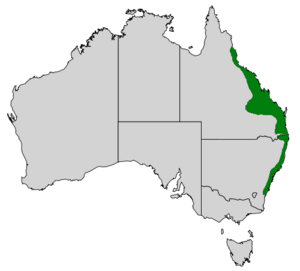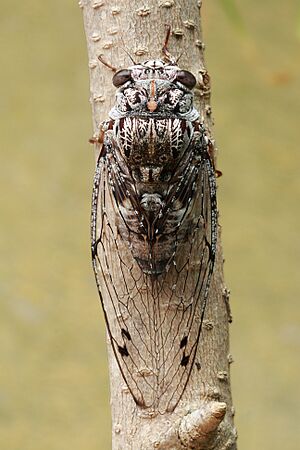Aleeta curvicosta facts for kids
Quick facts for kids Aleeta curvicosta |
|
|---|---|
 |
|
| Scientific classification | |
| Genus: |
Aleeta
|
| Species: |
curvicosta
|
 |
|
| Aleeta curvicosta range | |
| Synonyms | |
|
|
The Aleeta curvicosta is a type of cicada often called the floury baker or floury miller. Until 2003, it was known as Abricta curvicosta. This insect is very common in Australia, especially along the eastern coast. It was first described in 1834 by a scientist named Ernst Friedrich Germar. The floury baker is the only known species in its genus called Aleeta.
Kids often find the floury baker interesting because of how it looks and its loud sound. Its name comes from the white, powdery stuff that covers its body, making it look like it's dusted with flour. The cicada's body and eyes are usually brown with lighter patterns. It has a light line down the middle of its back. Its front wings have dark brown spots. Female floury bakers are usually bigger than males. Their size can also change depending on where they live, with bigger ones found in places with more rain. Male cicadas have special parts that help them make a very loud and complex call. They do this by quickly flexing ribbed body parts called tymbals. Air sacs in their belly help make the sound even louder.
Floury bakers usually live alone and are not found in huge groups. They typically come out of the ground between late November and late February. You can see them until May. These cicadas like to live on many different types of trees, especially paperbark trees. They are not very good at flying. Other insects like cicada killer wasps and many kinds of birds hunt them. They can also get sick from a special fungus that affects cicadas.
Contents
About Its Name
A German scientist named Ernst Friedrich Germar first described the floury baker in 1834. He called it Cicada curvicosta. Later, in 1866, a Swedish scientist named Carl Stål created the genus Abricta. For a long time, the cicada was known as Abricta curvicosta.
In 2003, scientists studied the Abricta group more closely. They found that the Australian cicadas in this group were actually quite different from each other. Max Moulds, an Australian scientist, looked at their body shapes. He found that the floury baker was very different from the other 14 Australian species. Because of this, it was placed in a brand new genus called Aleeta. Most of the other species went into a genus called Tryella.
The name Aleeta comes from the Greek word aleton, which means flour or meal. This is why it's called the "floury baker." People started using the names "baker" and "miller" for this cicada by 1860 because of its dusty, flour-like look.
What It Looks Like
The floury baker is a medium-sized cicada. Its body is about 2.9 cm (1.1 in) long. Its front wings are between 3 and 5.1 cm (1.2–2 in) long, and its wingspan is about 9–10 cm (3.5–4 in). It weighs around 1.02 g (0.036 oz). The size of individual cicadas can change a lot depending on how much rain an area gets. In places with more rain, like coastal areas, they tend to be much larger.
Adult floury bakers are brown and look like they've been dusted with white powder. Fine white hairs cover most of their body, legs, and some parts of their wings. However, these hairs can rub off easily, especially on older cicadas. All floury bakers have a pale line down the middle of their back. Their legs are brown, sometimes yellowish. Their eyes are dark brown. They also have yellowish flaps called opercula that stick out from their sides. Female cicadas are a bit bigger than males and have similar colors, though they might be slightly paler.
Their wings are clear with black or brown veins. They have dark brown or black patches at the base of some cells on their wings. These patches can sometimes connect to form a zigzag pattern. The wing surfaces have tiny bumps that help them stay clean and make them less shiny, which helps with camouflage.
The male's call is a unique hissing sound. It starts with short bursts, about one second apart. Then, these bursts get faster until they become a steady hiss that lasts for 7–10 seconds. People describe the sound as "rp, rp, rp, rp, rrrrrp." This sound is made when muscles quickly click parts of their body called tymbals inward. Each click makes a pulse of sound. The cicada does this very fast, making a loud sound that can reach 9.5–9.6 kHz.
Air sacs in the cicada's belly act like speakers to make the sound louder. The floury baker can quickly move its belly up or down to change the sound's volume or pitch. This helps male cicadas attract females. The floury baker is known as one of Australia's loudest cicadas.
Life Cycle
Female floury bakers lay their eggs in small cuts they make in live branches or twigs of trees. They usually lay about sixteen eggs in each cut, with a total of a few hundred eggs in one batch. The eggs hatch about 70 days later, usually all around the same time. However, it can take longer if the weather is cold or dry. They lay eggs on many different native and introduced plants. This can sometimes weaken the branches of young fruit trees.
After hatching, the tiny nymphs fall from the branches. They then look for a crack in the soil to burrow into. They dig with their large front legs, often going 10–40 cm (4–16 in) deep. Larger cicada species like the floury baker are thought to spend 2–8 years underground. During this time, they grow and feed on sap from tree roots using their special mouthparts called a rostrum. They shed their skin five times before they come out of the ground for the last time.
When they are ready, the nymphs emerge from the ground at night. They grab onto tree bark with all their legs. They then swallow air and push fluid around their body to split their old skin down the back. They pull out their head and then arch their back to get their legs free. Slowly, they unfold their wings. Finally, they bend forward and pull their belly free from the old skin. Once out, they hang for several hours while their wings get hard.
Most adult cicadas live for only about two to four weeks after they emerge. During this short time, they feed on sap from tree branches. They also mate and lay eggs to start the cycle all over again.
Where They Live
The floury baker cicada can be found from the Daintree River in northern Queensland all the way down to Bendalong in southern New South Wales. In the northern parts of its range, it lives in higher areas like the Atherton Tableland. But in the southern parts, it lives in lower areas. You can find it in many different places, from the edges of rainforests to suburbs, even in the middle of Sydney.
How They Behave
Floury bakers usually live alone. Studies have shown there are only about 50 of them per hectare in some areas. This is much less dense than some other Australian cicada species. Adult floury bakers usually sit facing downwards on tree branches, not on the main trunk. They are found on many types of plants, especially those in the Myrtaceae family, like different kinds of paperbark and bottlebrush plants. They also like brown hazelwood and pegunny trees. These are likely the same plants that the nymphs feed on underground.
Compared to other Australian cicadas, floury bakers are not very good at flying. They are slow, usually flying at about 2.1 m/s (6.9 ft/s). When chased, they can speed up to about 3.9 m/s (13 ft/s). Their flights are usually short, lasting around 3.4 seconds, and they change direction often. They are also not very good at landing. They don't react to people approaching them until they are quite close.
Who Hunts Them
Many birds hunt adult floury bakers. These include wrens, grey fantails, noisy miners, blue-faced honeyeaters, little wattlebirds, grey and pied butcherbirds, magpie-larks, Torresian crows, white-faced herons, and even the nocturnal tawny frogmouth. Frogmouths and bearded dragons have also been seen eating nymphs as they emerge from the ground.
Some Australian cicadas can get a special fungus called Massospora. This fungus grows on their body and can cause their tail end to fall off. Floury bakers are also hunted by the cicada killer wasp (Exeirus lateritius). This wasp stings and paralyzes cicadas high in the trees. The paralyzed cicadas fall to the ground. The wasp then carries them, sometimes for up to 100 m (330 ft), to its burrow. Inside the burrow, the helpless cicada becomes food for the wasp's young.
In Popular Culture
Children often collect the empty shells that cicada nymphs leave behind. Sometimes they even attach them to their clothes. Schoolchildren have been known to bring live adult cicadas into classrooms to surprise everyone with their loud "shrieking," much to the teachers' annoyance! Kids often climb trees to catch them and keep them as temporary pets in shoeboxes. However, they can't be kept for more than a day or two because they need fresh sap from trees to eat. A poem about the floury baker, explaining its life cycle to children, was published in the Catholic Press newspaper in 1930.
See also




